Media | Articles
10 vintage pickups for $20,000 or less
Who doesn’t love a vintage pickup? With their simple layouts and sturdy construction, there are plenty of examples of old iron that would make great projects. We’re not trying to rationalize adding another vehicle to your collection, but if you’re already eyeing that empty bit of space in your garage and picturing how you’d fill it, perhaps a classic pickup truck isn’t the worst option. True, that spot might have to be a bit bigger than the space needed for a sporty roadster, but you typically can’t fit a pair of motorcycles or half a cord of wood into the trunk of a Triumph. OK, maybe we are trying to rationalize adding another vehicle to your collection.
We had our valuation specialists look through the latest numbers and we picked out a wide variety of pickups from an array of manufacturers that can all be had in #3 (Good) condition for less than $20,000. A vehicle in #3 condition could be a candidate for sprucing up or enjoying as-as, and putting the bed to use as intended. This list of sub-$20,000 pickups is far from exhaustive—there are plenty more out there that should fit just about every classic pickup lover’s fancy. Do any of these parts haulers and workhorses have a place in your collection?
1930 Model A open cab pickup

The Model A Ford was available in a staggering number of body styles, from roadster and cabriolet to coupe, sedan, and pickups both with and without a metal roof. This is one case where the adage, “if the top goes down, the price goes up” doesn’t apply as the roadster pickup has recently dropped in price to come in under our $20,000 threshold. All of the same hot-rodding principles apply to these pickups, and while their banger engines can be hopped up, they also look and perform quite nicely with a flathead V-8 swapped in and the hood sides removed to show it off.
1959 Studebaker Deluxe 1/2-ton 259 V-8

Studebaker ushered in a new generation of pickups in 1960, with sheet metal based on their car lineup, so the 1959 pickups were nearing the end of an era. These curvy trucks eschewed the quad-headlamp look that the Big Three had all adopted by 1959, so they might have looked a bit dated when new, although we think the style has aged just as nicely as many of its contemporaries. The half-ton we picked comes with a 259-cubic-inch V-8. If this were in our collection we’d enjoy taking it to shows, and it’d no doubt be the only one of its kind in attendance.
1967 Chevrolet C10 short-bed fleetside 327 V-8
Another that came in just under our $20K cap, the first year of a new pickup generation brought the ’67 Chevy pickups gorgeous styling. This was the only year of this era without side marker lights, making for a clean, uncluttered design. This generation has aged well and has been a mainstay among pickup fans for ages. The long trailing arms used on the rear suspension of the 2WD pickups gave them great handling for the era and their enduring popularity have helped aftermarket suppliers make all sorts of restoration and restomod parts available. Equipped with a 327 cubic-inch small-block V-8, this could be a great parts hauler to match your Bow Tie muscle car.
1973 International Wagonmaster 1110 392 V-8
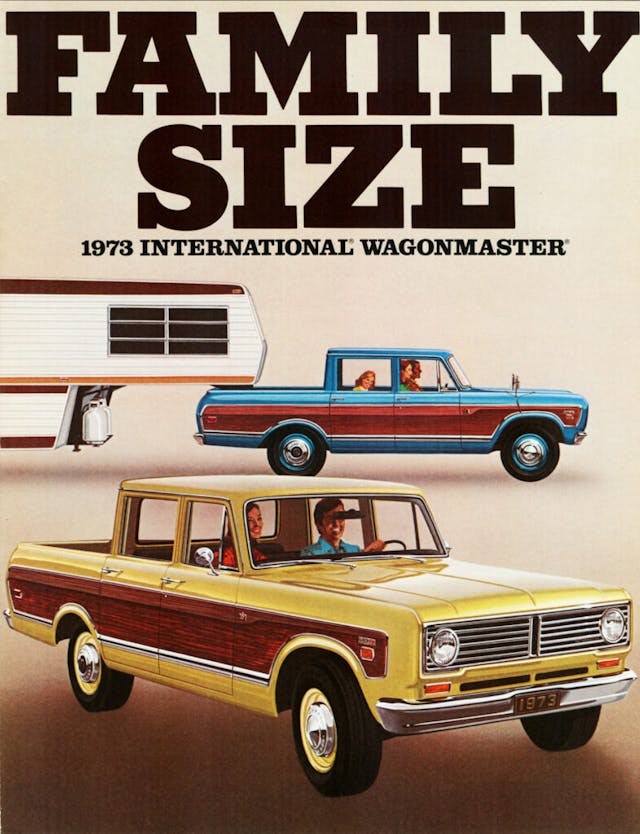
International Harvester built several interesting vehicles despite being outmanned and outspent by the Big Three, and as a result they’ve also cultivated a sizable cadre of dedicated enthusiasts. They were sort of like the AMC of pickups and SUVs, except that AMC also made pickups and SUVs. We think you get the point. The Wagonmaster was an ingenious product that proved to be way ahead of its time. The concept: take a four-door SUV and remove the rear roof section to build a crew-cab pickup. It’s the recipe that would eventually give us the Chevrolet Avalanche decades later. The Wagonmaster also existed long before crew-cab pickups became the largest share of the pickup market, so if you’re looking for the combination of four-passenger practicality and short-bed utility in a pickup from the ‘70s, your options are limited. The one we picked is powered by a big International V-8 engine, that comes in a displacement familiar to Mopar fans: 392 cubic inches. International’s family of V-8 engines are known for being heavy as heck, but they also come with a reputation for being bulletproof.
1979 Jeep J-10 Custom Townside short bed 4×4 360 V-8
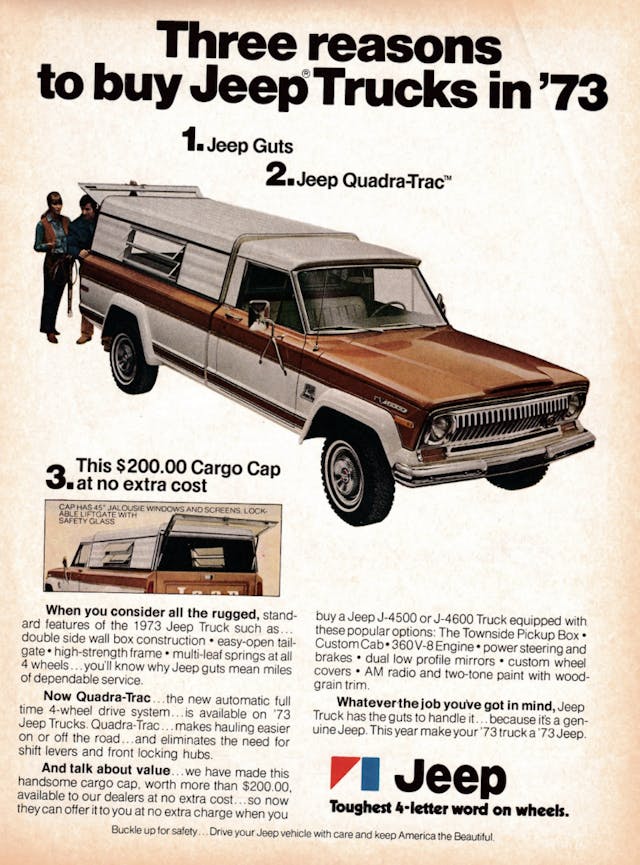
Before the Gladiator was based on a Wrangler and the Comanche was based on the XJ Cherokee, Jeep’s pickups were built on a full-size platform shared with the venerable Wagoneer. These pickups were powered by AMC’s inline-six or the optional 360 V-8 like the one we’ve chosen here, and the 4×4 versions came equipped with Jeep’s Quadra-Trac 4×4 system with low range. These pickups might be a bit more difficult to find parts for compared to their Big Three contemporaries, although there are plenty of reproduction graphics available to give it a Honcho or Golden Eagle upgrade, which kind of makes up for it. The Golden Eagle models are a bit more desirable and fell just outside of our $20,000 cap.
1985 Toyota SR5 4×4 Xtra Cab 22R-E

The styling of the 1984-1988 Toyota pickups has aged quite well in our opinion, and the values of SR5 4x4s across the range is rather similar, so take your pick of 2bbl carbureted 22R engine or the fuel-injected 22R-E model for a bit more power. We gave our nod to the 1985 model for a couple of reasons. It was Marty McFly’s pickup of choice and looks great with a mild lift and some added lights, even if you don’t want to go full Back to the Future regalia. It also was the final year of a solid front axle in 4×4 models, making it easier to upgrade for some weekend off-roading. These tough and simple trucks were at the forefront of building Toyota’s reputation for reliability.
1985 F-350 Crew Cab 4×4 460 V-8
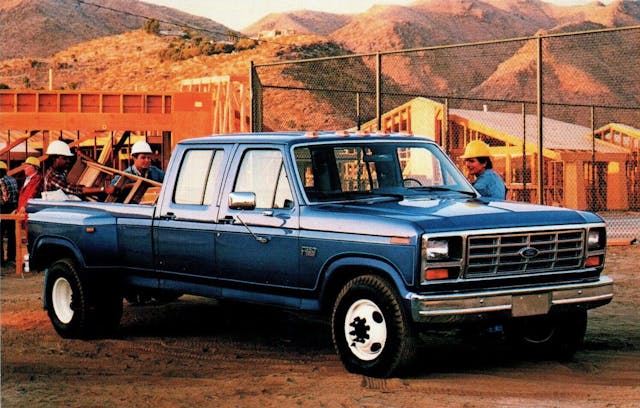
You’d have to clear a massive parking spot for this behemoth, one of the largest pickups in our lineup. In exchange you’ll get a roomy cabin with seating for up to six, an eight-foot bed, and a gargantuan big-block V-8. Ford had yet to make the switch to fuel injection, so you’ll have ample opportunity to tune up the 460 with your choice of parts or convert it to EFI, which Ford did itself in 1988. It’s true, the big-block is no powerhouse by today’s standards—today’s F-150 comes with a base 2.7-liter EcoBoost V-6 that can outpower this 460, but it’s tough to knock the simplicity of this pushrod brute.
1987 GMC V1500 4×4 350 V-8
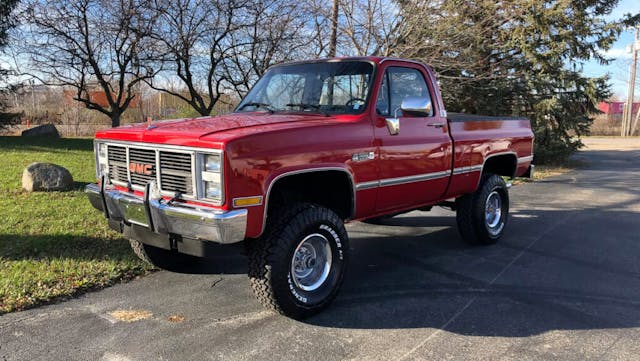
Square-body GM 1/2-ton pickups have seen renewed interest in recent years, and 1987 is the youngest, most developed model year you can buy in. By then, GM offered throttle body injection, and while crude, the system was also reliable. Top-shelf square-bodies can far exceed our $20k cap, but there are still plenty of good ones available in a variety of configurations for not too much coin.
1989 Chevrolet K1500 Sportside 4×4 350 V-8

The GMT 400 generation of pickups sparked new life into the custom truck scene. Their clean, uncluttered lines look great lowered or lifted. Like its earlier brethren we mentioned, these used a simple TBI injection setup. Their cylinder heads, cam, and intake are among the least impressive ever installed on a small-block Chevy, so a set of remanufactured Vortec heads and a new intake that reuses the factory TBI is an OEM option for a major upgrade.
1990 Dodge W150 short bed 4×4 360 V-8
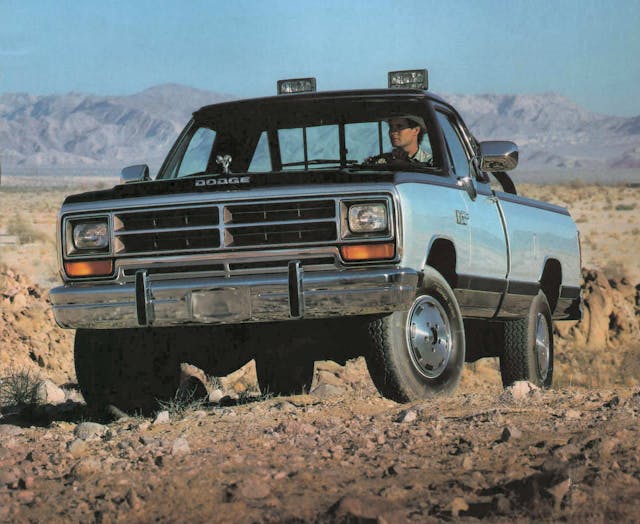
Just like Ford and GM, Dodge got a lot of mileage out of its 1970s-era cab design, with Dodge using the same basic structure from 1972 until the radical semi-truck-inspired Ram debuted in 1994. By the late ‘80s, Dodge had adapted TBI to its LA-based small-blocks, just as GM had done with its V-8s. Despite not having any design language in common with modern Rams, these trucks have a charm all their own. The 360 V-8 would wake up with a tune-up and we’d be tempted to backdate it with Macho Power Wagon graphics from the late ’70s.
***
Marketplace
Buy and sell classics with confidence
Check out the Hagerty Media homepage so you don’t miss a single story, or better yet, bookmark it. To get our best stories delivered right to your inbox, subscribe to our newsletters.












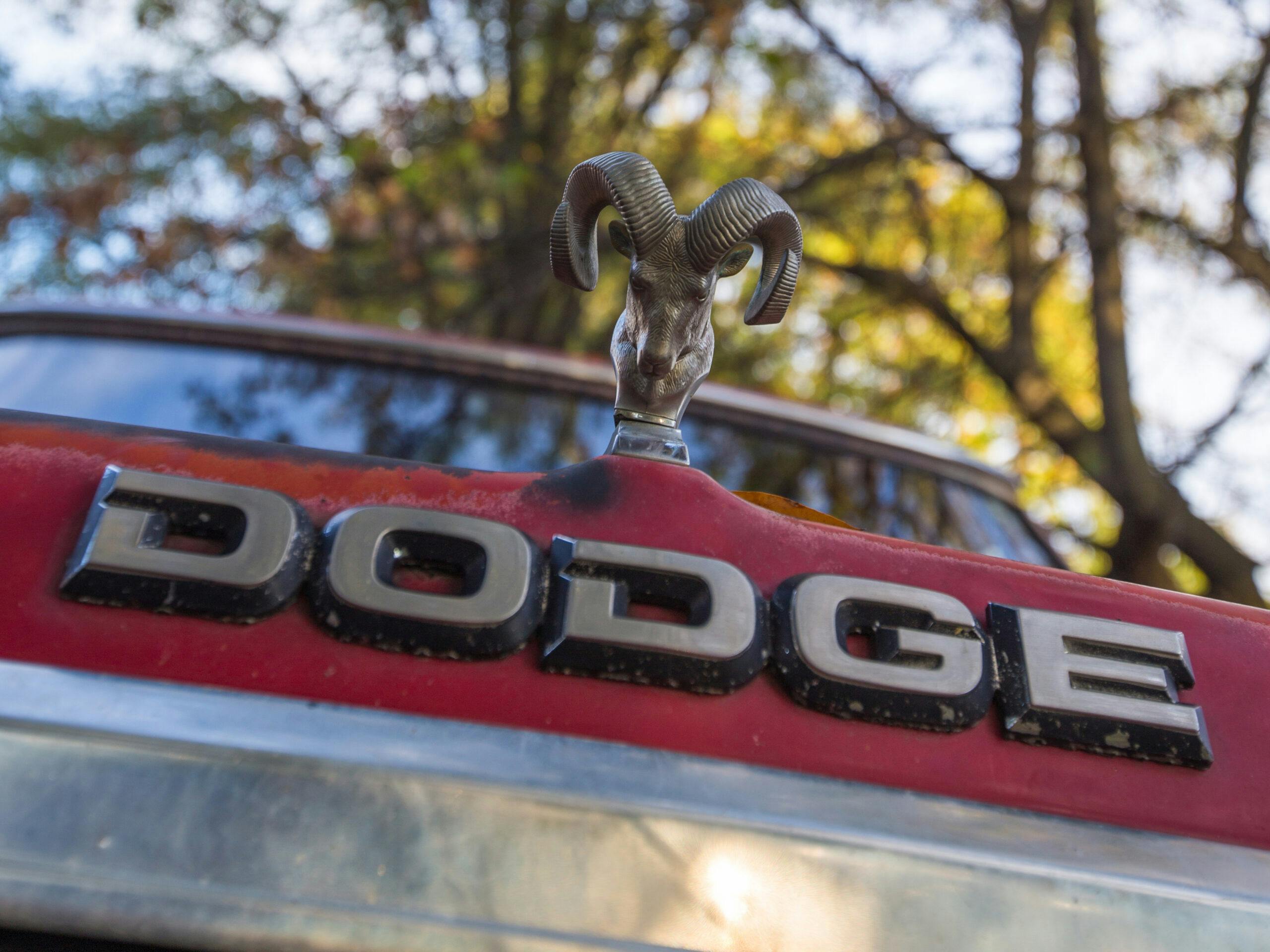
Ahh, the 80-86 Fords. I’ve got three of them at my house. What I don’t have though is a crew cab dually 4×4 example, and boy would I like to have one.
I have a 1950 Willys restored over a 1982 Jeep J-10 frame by R. Hodges. Wooden bed, one of a kind. A nice truck. Decided to sell it.
You’d never find one of the international wagon masters for less than 25 if your lucky to even find one.at that.
Right on. One sold last year on BAT for $37,000. Needs at least repairs to the seats, at least two gauges and/or sending units and/or circuitry, and a new steering wheel.
One sale does not make a market, especially not one BaT sale.
I’ll probably take Hagerty’s word before Don keote.
Got my 56 s120 4wd for free, was rusted up bad, all fixed now, runs great.
I bought one of those Toyotas new, though mine had only the standard cab. I would love to have another, but finding rust-free examples is difficult.
My neighbor has one he inherited from his dad. His father bought it new and he has kept it well maintained. No rust. Although I cringe every time I see him plow with it.
come to Texas
I’ve mentioned them before but I will again . The mid 90’s – 2000’s Mazda B/ Ford Ranger are great small pickups. And there are still plenty of them driving around in good or better shape. Even the battle scared units used for work keep on going well ,so if you don’t mind a few dents and scratches. I have to agree about the International. I think I’ve maybe seen one. But then again if I lived in Nebraska or..? So instead in the- ‘ I didn’t know they’ , ‘I’ve never seen one’- list, what are those 30’s -40’s Plymouth PT pickups selling for? It’s a shame they attached that name to the PT Wagon.
I have a 1939 dodge td15 red with black fenders
you lucky, lucky man. next to the late 70’s and 80’s vintage Dodge trucks, the 39 to 47 Mopar trucks are my favourite.
the only thing that killed my vintage 70s or 80s trucks up here was was the damn road salt. No stupid computers, simple electronic ignition, they just ran, all the time…..
The 1967 Chevrolet C10 short-bed fleetside & 1985 Toyota SR5 4×4 Xtra Cab would be my favorites from this list.
Tom B – Hard to argue that ( deep? ) red/black fender look on a truck. Vintage Texaco that always looks great. I always like that creamy beige brown fender look on a car of the same vintage (although I hate it generally elsewhere) simple, classic, with no need for further embellishment.
I have a 1984 F150 351, 4 on the floor, short box. Owned since new. Would take $20000.
I agree there! There is no way anyone would give $20k for some of these trucks.
How does the Ford F100 not make this list? Especially the ’67-’72 bumpside?
I enjoy these articles from Hagerty. Perhaps the photos could represent the ‘good’ condition that the price points reference, instead of the current photos accompanying the article. The current pics look to be cherry, fully-restored way-far-above good condition, ergo, probably double the price, at least, mentioned in the article.
Never could understand why anyone would lower a pickup.
I have asked myself that for years.
Same reason they use social media: in effort to get a date.
I’ve never known or heard of a girl that thought lowered trucks were “cute”. I’m pretty sure guys do it for the same reason they lift their trucks 12 inches: for looks; and that’s really the only reason. To each his own, but those of us that keep a truck for practical reasons will no doubt agree that they’re both useless.
>> … I’ve never known or heard of a girl that thought lowered trucks were “cute”. <> I’m pretty sure guys do it for the same reason they lift their trucks 12 inches: for looks; and that’s really the only reason.<<
… and the "looks" create status in a community. Status in the community is a prime reason for a woman's interest in a man.
Incidentally I'll say I've built and driven iterations of all three ride heights. They all got their various … social and work … jobs done, plus, they amused me.
With that name, not sure girls will want to get in your truck anyway. However, I lowered my ford Ranger because the factory stance just didn’t cut it. Too tall, handled poorly, now I get lots of compliments on it. It never gets off road. I have lowered most of my cars a bit. My first car was lowered by Sam Barris to the tune of $4 in 1960 when he lived in Carmichael. On the other hand, I don’t understand why some jack their show trucks up so high the girl has to have a step ladder to get in it. They look like a shock absorber display. Each to his or her own, makes life fun doesn’t it.
No mention of the Ford F100 “unibody” made for 3 years.
I have a 1963, pretty much stock except for the vintage Craigers.
$20000 will take it as I want a hot rod instead.
Ford F100’s are ok for a trip to the lumber yard but the Uni-Body wouldn’t hold up if you were doing much hauling . More of a city type truck for pulling a small boat or trailer.
Most of the IHC Wagonmasters and Travelettes were shipped to Vietnam for military command and communications vehicles, so they are hard to find in great shape. They were either used up or rusted to pieces state side!
Our Air Force unit in Vietnam had a Dodge crewcab pickup with a big mother engine–that thing would really haul a–, especially if we were driving it and a rocket attack started!
i cannot imagine what the adrenaline rush must have felt like, with a combination of speed and explosions….
That ‘85 Toyota is gorgeous. Unless it’s pictured next to one of today’s monstrosities it’s hard to see just how small they were. Imagine fitting your truck into a normal parking spot! Regardless of your taste, these trucks (and many others) are killer and were actually designed for the driver, maybe a passenger, and a load of s**t in the bed the way God intended, as opposed to the 2-rows-of-seats glorified El Camino’s we have today. Appreciate the article recognizing these classic forms of vehicles.
Drove an 85 Toyota extended cab as a work truck. The fold down seats were tiny, but it was great for running around and light loads. 6 or 7 guys drove that truck over 15 years, bed rusted out but not the cab. Threw a wood bed on it and it lasted another 5 years